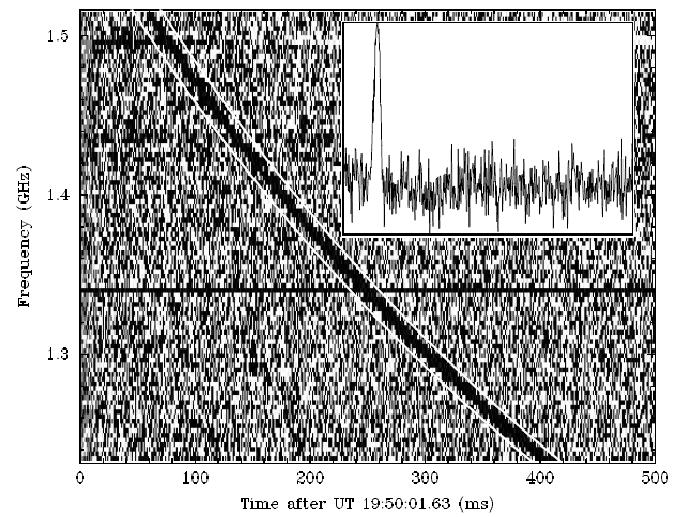Astropulse:科学原理
Astropulse 的基本原理
概要
Astropulse 是一种新式的 SETI 项目。它从原始的 SETI@home 发展而来,但它并不会替代 SETI@home。先前的SETI@home 是窄频带的,这意味着它只能收听某一特定的频率,这就好像欣赏管弦乐队演奏时尽力去辨别一个“A 升半音音符”,而 Astropulse 监听短时间脉冲。还是拿管弦乐队打比方,这就好像聆听某一记或某一连串鼓击。因为没人猜得到地外文明的信号听上去像什么,搜寻某几种信号听上去是个好主意。就科学而言,Astropulse 是一种以微秒级的瞬时无线电脉冲为目标的对天空的搜索。这些脉冲可能来自地外文明,也可能来自其他来源。我首先解释一下这个定义中使用的一些术语:
- 天空调查(Sky survey):我们使用阿雷西伯望远镜扫描天空,搜索来自每个角落的信号。这有别于定向的 SETI 搜索(那些望远镜对某几个特定恒星进行仔细搜索)。
- 微秒(Microsecond):就是百万分之一秒。Astropulse 在侦测时间很短的信号方面要优于先前的项目。只要信号长度不小于 0.4 微秒,信号越短,Astropulse 就越有优势。当信号长度小于 0.4 微秒,Astropulse 的优势就不再明显。
- 瞬时的(Transient):一个短信号就可以称之为瞬时信号。瞬时信号可能是重复的,也可能是单个的。
- 无线电(Radio):这些信号和 AM 或者 FM 广播一样由电磁辐射构成(大体上来说,信号的频率更高,但还是无线电信号)。电磁辐射包括无线电波,微波,红外线,可见光,紫外线,x射线和伽马射线。在项目网站的电磁辐射页面 可以找到更多有关电磁辐射的介绍。
一个被侦测到的脉冲
天文学家 Duncan Lorimer 和 Matthew Bailes 已经发现了一个短暂的无线电脉冲,据信该脉冲的发源地和地球距离 5 亿秒差(译注:1 秒差 = 3.2616 光年),超过十亿光年!那是如此遥远以至于我们甚至不能看到那个星系(也不知道这个星系是否确实存在)。没人知道是什么制造了这个脉冲...是地外文明?还是黑洞爆发?抑或是回转的中子星?下图为该脉冲图像:
在这幅图中,横轴代表时间,纵轴代表频率。这幅图显示脉冲的频率不断减小,这正是我们所盼望的“色散脉冲”(下文有解释)。
脉冲的来源
瞬时无线电脉冲有哪些来源呢?有以下几种可能性,包括:
- 地外文明(ET):先前的搜索活动已经通过搜索窄带信号来搜索地外文明(有点类似无线电台)。由于我们并不知道外星人的交流方式,这种办法似乎有些保守。
- 脉冲星和射电过客(Pulsars and RRATs):脉冲星是旋转的中子星,能够产生 100 毫秒级的信号(一般情况下会更长,0.4 毫秒似乎是个极限)。Astropulse 足以胜任对脉冲星的搜索,但并不擅长发现新的脉冲星。射电过客是最近发现的脉冲星的变体。也许 Astropulse 能够发现一类自转周期非常短的新旋转脉冲星类型。
- 爆发中的原始黑洞(Exploding primordial black holes):Martin Rees 推论认为一个爆发中的黑洞释放出的 Hawking辐射也许会产生能被无线电侦测到的信号。在项目网站的黑洞页面可以找到更多有关黑洞的信息。
- 银河系外脉冲(Extragalactic pulses):一些科学家最近发现了一个瞬时的无线电脉冲,它来自银河系外。我们不知道它是如何产生的,但或许Astropulse能发现更多。
- 未知的现象(New phenomena):也许最有可能的结果是发现一些未知的天体物理学现象。每当天文学家仰望星空,就可能会有新发现,无论是恒星,爆发,星系,还是别的新玩意。
Dispersed pulses
As a microsecond transient radio pulse comes to us from a distant source in space, it passes through the interstellar medium (ISM). The ISM is a gas of hydrogen atoms that pervades the whole galaxy. There is one big difference between the ISM and ordinary hydrogen gas. Some of the hydrogen atoms in the ISM are ionized, meaning they have no electron attached to them. For each ionized hydrogen atom in the ISM, a free electron is floating off somewhere nearby. A substance composed of free floating, ionized particles is called a plasma.
The microsecond radio pulse is composed of many different frequencies. As the pulse passes through the ISM plasma, the high frequency radiation goes slightly faster than the lower frequency radiation.When the pulse reaches Earth, we look at the parts of the signal ranging from 1418.75 MHz to 1421.25 MHz. This is a range of 2.5 MHz. The highest frequency radiation arrives about 0.4 milliseconds to 4 milliseconds earlier than the lowest frequency radiation, depending on the distance from which the signal originates. This effect is called dispersion. Click here to see how dispersed and undispersed pulses can be composed of many different frequencies.
In order to see the signal's true shape, we have to undo this dispersion. That is, we must dedisperse the signal. Dedispersion is the primary purpose of the Astropulse algorithm.
Not only does dedispersion allow us to see the true shape of the signal, it also reduces the amount of noise that interferes with the signal's visibility. Noise consists of fluctuations that produce a false signal. There could be electrical noise in the telescope, for instance, creating the illusion of a signal where there is none. Because dispersion spreads a signal out to be up to 10,000 times as long, this can cause 10,000 times as much noise to appear with the signal. (There's a square root factor due to the math, so there's really only 100 times as much noise power, but that's still a lot.)
The amount of dispersion depends on the amount of ISM plasma between the Earth and the source of the pulse. The dispersion measure (DM) tells us how much plasma there is. DM is measured in "parsecs per centimeter cubed", which is written pc cm-3. To get the DM, multiply the distance to the source of the signal (in parsecs) by the electron density in electrons per cubic centimeter. A parsec is about 3 light years. So if a source is 2 parsecs away, and the space between the Earth and that source is filled with plasma, with 3 free electrons per cubic centimeter, then that's 6 pc cm-3. The actual density of free electrons in the ISM is about 0.03 per cubic centimeter.
Astropulse algorithm
Single Pulse Loops
Astropulse has to analyze the whole workunit at nearly 15,000 different DMs (14,208, to be precise.) At each DM, the whole dedispersion algorithm has to be run again for the entire workunit. The lowest DM is 55 pc cm-3, and the highest is 800 pc cm-3. Astropulse examines DMs at regular intervals between those two. Without going into detail about how to examine a piece of a workunit at a given DM, here is the organization with which Astropulse handles the data: it divides the DMs to be covered into large DM chunks of 128 DMs each, and then small DM chunks of 16 DMs each. It divides the data into chunks of 4096 bytes, and processes them one at a time. Once it has dedispersed the data, Astropulse co-adds the dedispersed data at 10 different levels, meaning that it looks for signals of size 0.4 microseconds, then twice that, 4 times, 8 times, and so on. (0.4 microseconds, 0.8, 1.6, 3.2, 6.4, ...) On the lowest level of organization, astropulse looks at individual bins of data. A bin corresponds to 2 bits of the original data, but after dedispersion, it requires a floating point number to represent it. Here's the breakdown of Astropulse's loops:
1 workunit => 111 large DM chunks 1 large DM chunk => 8 small DM chunks 1 small DM chunk => 2048 data chunks 1 data chunk => 16 DMs 1 DM => 10 fold levels 1 fold level => 16384 bins (or less) 1 bin = smallest unit
So each workunit is composed of 111 large DM chunks, each of which is 0.901% of the whole. Each large DM chunk is composed of 8 small DM chunks, each of which is 0.113% of the whole. And so on.
The number of large DM chunks will probably change before the final version of Astropulse is released.
Fast Folding Algorithm
At the end of each small and large DM chunk, Astropulse performs the Fast Folding Algorithm. This algorithm checks for repeating pulses over a certain range of periods. (The period is the length of time after which the pulse repeats.) When the fast folding algorithm is performed after each large DM chunk, it searches over an entire 13 second workunit, and looks for repeating signals with a period of 256 times the sample rate (256 * 0.4 microseconds) or more. When the FFA is performed after each small DM chunk, it searches over a small fraction of the workunit, and looks for repeating signals with a period of 16 times the sample rate or more.
